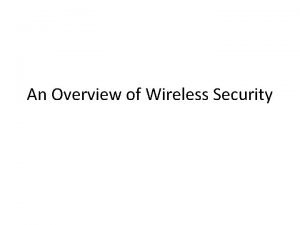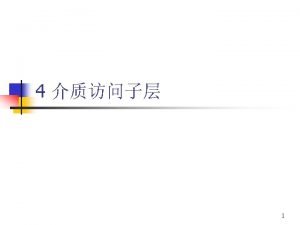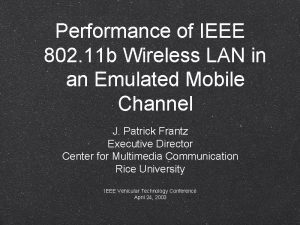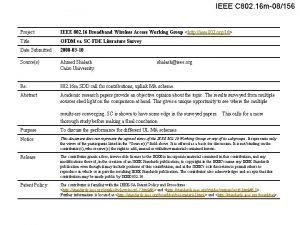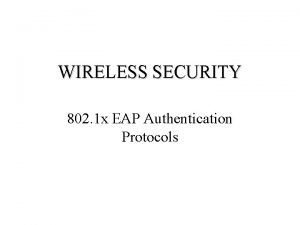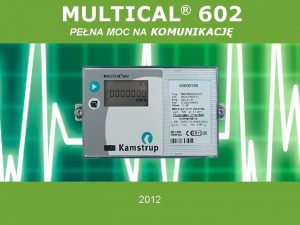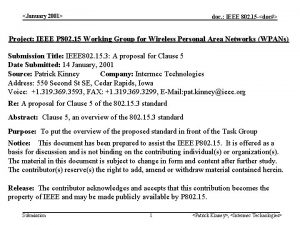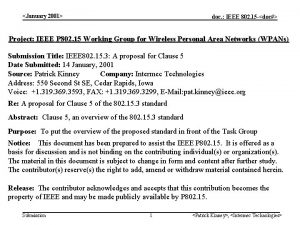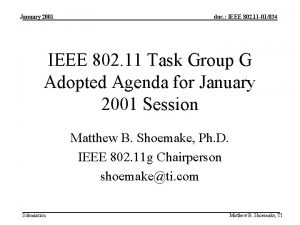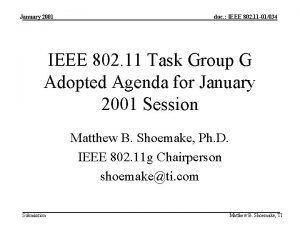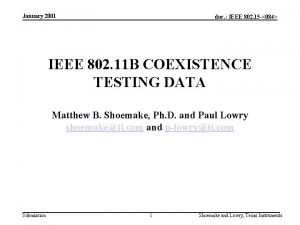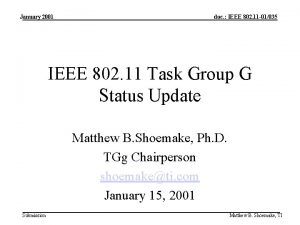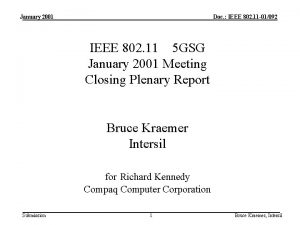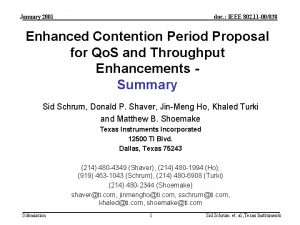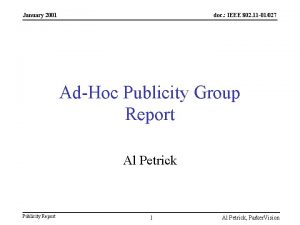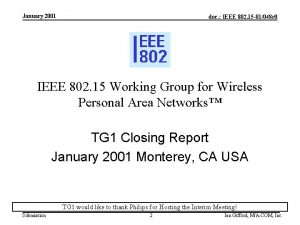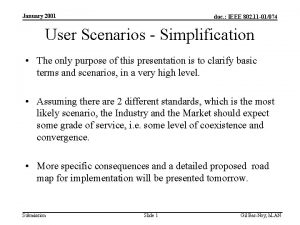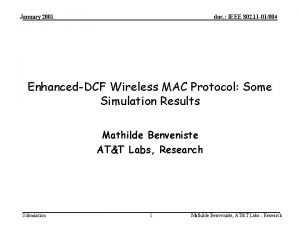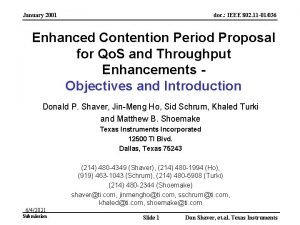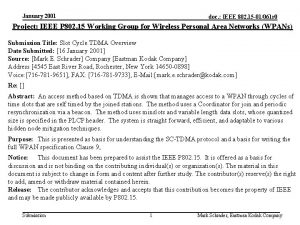January 15 2001 doc IEEE 802 15 01057

















- Slides: 17

January 15, 2001 doc. : IEEE 802. 15 -01/057 r 0 Project: IEEE P 802. 15 Working Group for Wireless Personal Area Networks (WPANs) Submission Title: Selective Hopping for Hit Avoidance Date Submitted: January 15, 2001 Source: KC Chen, HK Chen, CC Chao Company: Integrated Programmable Communications, Inc. Taiwan Laboratories Address: P. O. Box 4 -2, Chupei, Hsinchu, Taiwan 302 TEL: +886 3 553 9128, FAX: +886 3 553 9153, E-Mail: {kc, hkchen, ccc}@inprocomm. com Re: original document. Abstract: Submission to Task Group 2 for consideration as the coexistence mechanism for 802. 15. 2 Purpose: Description of Proposal Notice: This document has been prepared to assist the IEEE P 802. 15. It is offered as a basis for discussion and is not binding on the contributing individual(s) or organization(s). The material in this document is subject to change in form and content after further study. The contributor(s) reserve(s) the right to add, amend or withdraw material contained herein. Release: The contributor acknowledges and accepts that this contribution becomes the property of IEEE and may be made publicly available by P 802. 15. Submission 1 Integrated Programmable Communications, Inc.

January 15, 2001 doc. : IEEE 802. 15 -01/057 r 0 Selective Hopping for Hit Avoidance HK Chen, KC Chen, CC Chao Integrated Programmable Communications, Inc. Submission 2 Integrated Programmable Communications, Inc.

January 15, 2001 doc. : IEEE 802. 15 -01/057 r 0 Scenarios q Co-existence of 802. 15 and 802. 11 DS q Frequency hopping still follows FCC’s regulations q Other co-existence scenarios are not considered in this document ü Other FH at 2. 4 G Hz band ü Other DS at 2. 4 G Hz ISM band ü Shall be considered later • Principle is applied. • Procedures need more definitions. Submission 3 Integrated Programmable Communications, Inc.

January 15, 2001 doc. : IEEE 802. 15 -01/057 r 0 Frequency Arrangement of IEEE 802. 11 b and 802. 15 802. 11 b Channel Number Central Frequency (MHz) Range (MHz) 1 2412 2400 -2424 Correspondi ng Bluetooth Channel Numbers 0 -22 6 2437 2425 -2449 23 -47 11 2462 2450 -2474 48 -72 Submission 4 Integrated Programmable Communications, Inc.

January 15, 2001 doc. : IEEE 802. 15 -01/057 r 0 Frequency Partition Number Total Channel in the Partition 1 Correspondi ng Bluetooth Channel Number 0 -22, 75 -77 26 Correspondi ng 802. 11 Channel Number 1 2 23 -47, 78 26 6 3 48 -72, 73 -74 27 Submission 5 11 Integrated Programmable Communications, Inc.

January 15, 2001 doc. : IEEE 802. 15 -01/057 r 0 Two-Layer Hopping Sequences q. In case 802. 15 hopping channel is within the frequency range of a 802. 11 DS transmission üSelect a set of partition sequences from 3 possible sets üOriginal sequence is mapped into a new sequence according to the selected set of partition sequences Submission 6 Integrated Programmable Communications, Inc.

January 15, 2001 doc. : IEEE 802. 15 -01/057 r 0 Selective Hopping Avoidance System Architecture RSSI (& 802. 11 b locking detection) Demodulation with interference suppression RF input signal Frequency Synthesizer Multiplexer Partition mapping remapping Error Check Interference identification Optional indicator of 802. 11 DS from the 802. 11 -802. 15 integrated device Packet target Original/Map ped sequence selection Partition sequence generation Hopping sequence generation Partition sequence selection procedure Partition sequence change procedure Traffic requirement Uniform channel usage requirement Hopping clock Submission 7 Integrated Programmable Communications, Inc.

January 15, 2001 doc. : IEEE 802. 15 -01/057 r 0 Interference Identification q. It consists of üInstantaneous interference detection: interference-free or not • Checks of received packet and power level • Utilization of channel silent duration between channel active time üHit ratio measurement • Counting the interference ratio for each partition Submission 8 Integrated Programmable Communications, Inc.

January 15, 2001 doc. : IEEE 802. 15 -01/057 r 0 Partition Sequence Selection Under Uniform Channel Utilization 1. 2. 3. 4. 5. For partitions with interference hit ratios below threshold, corresponding hit ratios are set to be zero. From the time slots reserved by the traffic requirements, calculate the partition usage vector for partition sequences. Calculate the average hit probability H(p) for each type p of partition sequence Select the partition sequences with minimal H(p) If more than one in step 4, select the most evenly used one Submission 9 Integrated Programmable Communications, Inc.

January 15, 2001 doc. : IEEE 802. 15 -01/057 r 0 Partition Sequence Change Procedure q. After the device decides to apply a new partition sequence, it starts to communicate with all its peers. üNegotiate with peers to change to new hopping sequence üIn case no support of co-existence in peers, original sequence is still used. Submission 10 Integrated Programmable Communications, Inc.

January 15, 2001 doc. : IEEE 802. 15 -01/057 r 0 Original/Mapped Sequence Selection q. Designed for backward compatibility üAllowing original sequence and mapped sequence co-existing in a pico-net. üMaster selects an appropriate sequence based on the targeting receiver(s). üA simple directory records • Peers • 802. 15. 2 compliance or not • Sequence used Submission 11 Integrated Programmable Communications, Inc.

January 15, 2001 doc. : IEEE 802. 15 -01/057 r 0 Partition Sequence Generation q One table contains all possible types of sequences. q To reduce implementation complexity, a small set of partition sequences, containing enough sequences to optimize hit probability for any combination of interference and traffic situations, is desired. ü For 802. 15, SCO traffic has the highest priority need using partition sequences. q It can be generalized to all co-existing environments. Submission 12 Integrated Programmable Communications, Inc.

January 15, 2001 doc. : IEEE 802. 15 -01/057 r 0 Traffic Requirement Submission Traffic combinations Bluetooth traffic parameters Corresponding traffic parameters 1 One full-duplex SCO link, Tsco=4, Dsco=0, 1 Tstep=2, offset=0 2 One full-duplex SCO link, Tsco=4, Dsco=2, 3 Tstep=2, offset=1 3 One full-duplex SCO link, Tsco=6, Dsco=0, 1 Tstep=3, offset=0 4 One full-duplex SCO link, Tsco=6, Dsco=2, 3 Tstep=3, offset=1 5 One full-duplex SCO link, Tsco=6, Dsco=4, 5 Tstep=3, offset=2 7 Two full-duplex SCO link, Tsco=6, Dsco=0, 1, 2, 3 Tstep=3, offset=0, 1 8 Two full-duplex SCO link, Tsco=6, Dsco=0, 1, 4, 5 Tstep=3, offset=0, 2 9 Two full-duplex SCO link, Tsco=6, Dsco=2, 3, 4, 5 Tstep=3, offset=1, 2 13 Integrated Programmable Communications, Inc.

January 15, 2001 doc. : IEEE 802. 15 -01/057 r 0 Example of Partition Usage Vector Submission Traffic combinat ion Corresponding traffic parameters 1 Tstep=2, offset=0 1 0 2 2 Tstep=2, offset=1 1 2 0 3 Tstep=3, offset=0 2 0 0 4 Tstep=3, offset=1 0 1 1 5 Tstep=3, offset=2 0 1 1 6 Tstep=3, offset=0, 1 2 1 1 7 Tstep=3, offset=0, 2 2 1 1 8 Tstep=3, offset=1, 2 0 2 2 14 Integrated Programmable Communications, Inc.

January 15, 2001 doc. : IEEE 802. 15 -01/057 r 0 Partition Mapping Selected channel number of original hopping sequence Mapping table of P 3 Select one table among the three Mod Nj Nj Channels in Pj P 1 P 2 P 3 Partition sequence Submission 15 Integrated Programmable Communications, Inc.

January 15, 2001 doc. : IEEE 802. 15 -01/057 r 0 Rearrangement as an Alternative of Sequence Generation q Temporary re-arrangement of pre-determined N channels of hopping sequence ü Taking advantage of interference duty cycle ü Can also be used for smaller ISM bandwidth at certain countries. ü Algorithm: 1. Determine coming hopping channel suffering interference of a 802. 11 DS transmission. 2. Create the segment of upcoming N elements in the hopping sequence. Initial suggestion: N=4 -8. 3. Move those in the interference band to the end of the segment. The rest of sequence is kept the same. 4. Inform/negotiate peer(s) as our earlier procedure. Submission 16 Integrated Programmable Communications, Inc.

January 15, 2001 doc. : IEEE 802. 15 -01/057 r 0 Features of Selective Hopping Avoidance q Backward compatible (in function) q Meeting FCC regulations ü Global consideration q Traffic based ü Primarily SCO in 802. 15 ü Re-arrangement as an alternative q Just being extra module in implementation, that is, backward compatible in implementation ü Simple and no other new functions from 802. 15/11 ü Considering (802. 11/802. 15) integrated devices Submission 17 Integrated Programmable Communications, Inc.











